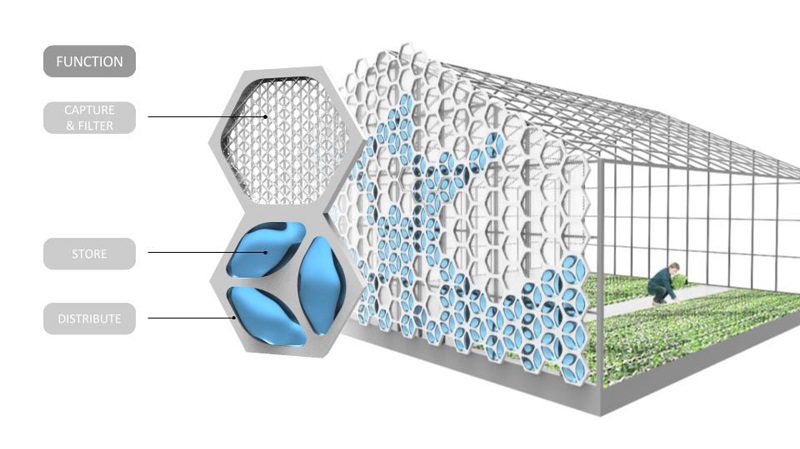|
|

|
  
Features
Update 2017/10/30
Biomimicry
LIFE IMITATING NATURE - BIOMIMICRY AND THE AQUAWEB
This story is brought to you in part by Waterloo Biofilter Systems
By Cori Marshall
Our urban areas are filled with inorganic straight lines, our buildings and streets. These environments are void of the organic flowing lines that you would find in nature. Nature has found ways adapt and thrive over hundreds of millions of years, and may hold the answers to contemporary society's sustainability challenges.
The answer may be biomimicry, which the dictionary defines as "the imitation of natural biological designs or processes in engineering or invention." That seems like such a cold sterile way of describing a concept that can very well change the way we approach urban agriculture and find sustainable solutions to climate change.

Photo courtesy of NexLoop
The NexLoop Team has developed a prototype for the AquaWeb, an intricate nature imitating system that captures, filters, stores and distributes water for urban agriculture.
We spoke with Anamarija Frankić, Ph.D., the Director of the Green Harbors Project® and Biomimicry LivingLabs®, and a Co-Founder of the NexLoop Team along with Jacob Russo. The project had many international contributors since it began two years ago, and Frankić describes it as "a kind of cross-pollination [of people] from different backgrounds which is the key point in imitating nature."
The project took an interdisciplinary approach, which is one that Frankić encouraged saying "we are really building a community of diverse expertise. Biology, design and architecture are not going to solve the problem by themselves, we need to bring an interdisciplinary community approach to build solutions that are organic or nature based."
The AquaWeb "was developed to mimic something that nature does at every single scale, from nano to macro," Frankic explained. The AquaWeb was envisioned to be "modular and scalable so we can use it in different environments." The application can be used in arid, wet and urban settings as well as for greenhouses and other urban agricultural setups.
"The number one problem of food production is the water source," Frankić said. She added that "when you look in nature, [it] can extract water from the air, it doesn't matter if it is in the desert or tropical forests."
"In urban settings, we have already changed the microclimate, so we are trying to figure out how can we build infrastructure in a human-built system that can bio-mimic nature. Just imagine if you had a building that could absorb, store, clean the water itself and use it for food production. " Anamarija Frankic, Ph.D.
Need for an application like the AquaWeb is rooted in how humans have transformed nature to suit our needs. Frankić explained that "we replaced the ecological functions of the forest, marshes, and estuaries in general with our built environment [and] it doesn't have any ecological function."
"You have cities that are using nature, using everything that is around us and the feedback loop is negative because it is producing pollution and degrading the system," Frankić said. The NexLoop vision was to "bring back the ecological functions in a scalable way."
Frankicć and the NexLoop team drew their inspiration from hundreds of species when designing the AquaWeb the cribellate orb weaver spider, crystalline ice plant, jersey cow mushroom, and dwarf honey bee are a few examples.
The team was careful to use "materials that were organic, and not harmful to nature," she said.
The NexLoop team, and biomimetics, in general, are trying to provide sustainable solutions in a proactive way instead of being reactionary. Societies are responding to unpredictable storms due to climate change "instead of thinking how does nature do it, it has been doing it for hundreds of millions of years adapting and evolving," Frankić said. "We've just missed that connection trying to solve the problems together with nature and seeing ourselves as part of that nature," she added.
In developing their prototype, the NexLoop team learned from indigenous cultures around the world and Canada, building on their traditional knowledge.
The AquaWeb prototype won the $100 thousand Ray of Hope Prize at the Biomimicry Global Design Challenge, which is organized by the Biomimicry Institute.
We also spoke with Megan Schuknecht, the Director of Design Challenges at the Institute.
Schuknecht explained that "through the Global Design Challenge, we are encouraging people to come up with sustainable solutions to the challenges of our time such as water management, energy management, food system solutions and now our current theme is around climate change."
She added that one of the ways we can address climate change is looking at how nature uses energy, uses carbon, highly efficient processes, and simple building blocks, we create healthy ecosystems in the process."
The Biomimicry Institute exists to "empower people to create nature-inspired solutions for a healthy planet."
With growing urban populations around the globe, the AquaWeb could help in sustaining those populations. To address the current unsustainable situations that we have created, it is a wise choice to look to nature for solutions.
|
|
|
Have a question? Give us a call 613-501-0175
All rights reserved 2025 - WATERTODAY - This material may not be reproduced in whole or in part and may not be distributed,
publicly performed, proxy cached or otherwise used, except with express permission.
|
| |